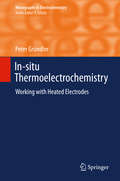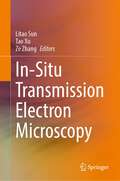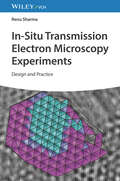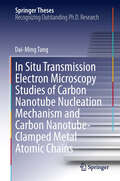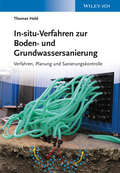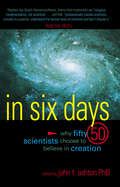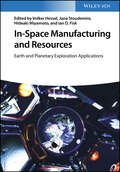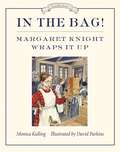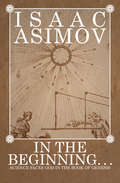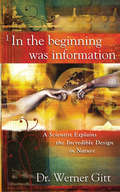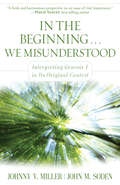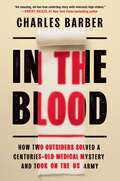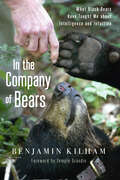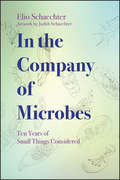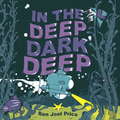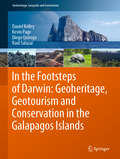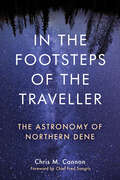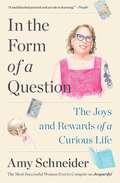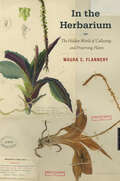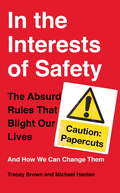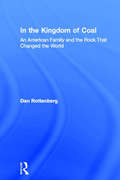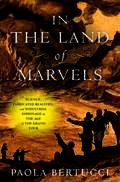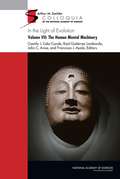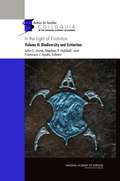- Table View
- List View
In-situ Thermoelectrochemistry
by Peter GründlerThis book represents the first rigorous treatment of thermoelectrochemistry, providing an overview that will stimulate electrochemists to develop and apply modern thermoelectrochemical methods. While classical static approaches are also covered, the emphasis lies on methods that make it possible to independently vary temperature such as in-situ heating of electrodes by means of electric current, microwaves or lasers. For the first time, "hot-wire electrochemistry" is examined in detail. The theoretical background presented addresses all aspects of temperature impacts in the context of electrochemistry.
In-Situ Transmission Electron Microscopy
by Litao Sun Tao Xu Ze ZhangThis book focuses on in-situ transmission electron microscopy (TEM), an investigatory technique used to observe a sample’s response to a given stimulus (including electron irradiation, thermal excitation, mechanical force, optical excitation, electric and magnetic fields) at the nanoscale in real time. The book introduces readers to the technical strategy behind the in-situ technique and its developments. It reviews the research frontiers of using in-situ TEM in energy conversion and storage, catalysis, nanomaterials synthesis, nanoelectronics, etc. Furthermore, it discusses the future prospects for in-situ TEM. The book offers a valuable guide for all undergraduate and graduate students who are interested in TEM characterization technology. It also serves as a reference source on cutting-edge in-situ techniques for researchers and engineers.
In-Situ Transmission Electron Microscopy Experiments: Design and Practice
by Renu SharmaIn-Situ Transmission Electron Microscopy Experiments Design and execute cutting-edge experiments with transmission electron microscopy using this essential guide In-situ microscopy is a recently-discovered and rapidly-developing approach to transmission electron microscopy (TEM) that allows for the study of atomic and/or molecular changes and processes while they are in progress. Experimental specimens are subjected to stimuli that replicate near real-world conditions and their effects are observed at a previously unprecedented scale. Though in-situ microscopy is becoming an increasingly important approach to TEM, there are no current texts combining an up-to-date overview of this cutting-edge set of techniques with the experience of in-situ TEM professionals. In-Situ Transmission Electron Microscopy Experiments meets this need with a work that synthesizes the collective experience of myriad collaborators. It constitutes a comprehensive guide for planning and performing in-situ TEM measurements, incorporating both fundamental principles and novel techniques. Its combination of technical detail and practical how-to advice makes it an indispensable introduction to this area of research. In-Situ Transmission Electron Microscopy Experiments readers will also find: Coverage of the entire experimental process, from method selection to experiment design to measurement and data analysis Detailed treatment of multimodal and correlative microscopy, data processing and machine learning, and more Discussion of future challenges and opportunities facing this field of research In-Situ Transmission Electron Microscopy Experiments is essential for graduate students, post-doctoral fellows, and early career researchers entering the field of in-situ TEM.
In Situ Transmission Electron Microscopy Studies of Carbon Nanotube Nucleation Mechanism and Carbon Nanotube-Clamped Metal Atomic Chains
by Dai-Ming TangUsing an in situ transmission electron microscopy (TEM) approach to investigate the growth mechanism of carbon nanotubes (CNTs) as well as the fabrication and properties of CNT-clamped metal atomic chains (MACs) is the focus of the research summarized in this thesis. The application of an in situ TEM approach in the above-mentioned research provides not only real-time observation but also monitored machining and structural evolvement at the atomic level. In this thesis, the author introduces a CNT tubular nano furnace that can be operated under TEM for investigation of the CNT nucleation mechanism. By studying the nucleation process of CNTs in the presence of various catalysts, including iron-based metallic catalysts and silicon oxide-based non-metallic catalysts, the physical states of the catalysts as well as the nucleation and growth process of CNTs are revealed. Based on the understanding of the nucleation mechanism, the author proposes a hetero-epitaxial growth strategy of CNTs from boron nitride, which provides a new route for the controllable growth of CNTs. In addition, the author presents an electron beam-assisted nanomachining technique and the fabrication of a CNT-clamped MAC prototype device based on this technique. The formation process of CNT-clamped Fe atomic chains (ACs) can be monitored with atomic resolution. The demonstrated quantized conductance and uninfluenced half-metallic properties of Fe ACs indicate that CNTs can be promising nanoscale electrodes or interconnectors for the linking and assembly of nano and subnano structures.
In Situ Treatment Technology
by Evan K. Nyer Peter L. Palmer Eric P. Carman Gary Boettcher James M. Bedessem Frank Lenzo Tom L. Crossman Gregory J. Rorech Donald F. KiddCompletely revised and updated, the second edition of the bestselling In Situ Treatment Technology adds three new chapters to provide the reader with an even more comprehensive reference source on remediation. This authoritative book goes beyond discussion of individual in situ technologies by providing an understanding of the geologic foun
In-situ-Verfahren zur Boden- und Grundwassersanierung
by Thomas HeldBoden- und Grundwasserkontaminationen verursachen erhebliche Kosten, da aufwändige Sanierungen nicht nur Unternehmen, sondern oft auch die gesamte Volkswirtschaft belasten. Moderne In-situ-Verfahren verfolgen das Konzept, Schadstoffe in Böden und Grundwasser vor Ort in ungefährliche Stoffe umzusetzen. Durch Zugabe von Reagenzien werden Schadstoffe im Untergrund abgebaut oder in eine mobile, extrahierbare Form überführt. Doch nur mit dem nötigen Know-How lassen sich die Sanierungsverfahren auch effizient umsetzen. Mit diesem Buch werden die Grundlagen erarbeitet, die es ermöglichen, eine Boden und Grundwassersanierung zu planen, zu überwachen und erfolgreich zu beenden. Biogeochemische und physikalische Prozesse, die im kontaminierten Untergrund ablaufen, werden umfassend erläutert. Mit ingenieurtechnischem Ansatz und basierend auf der industriellen Praxis werden verschiedene Verfahren vorgestellt und unter sozioökonomischen und nachhaltigen Gesichtspunkten betrachtet. Denn nur wenn der gesamte Sanierungsprozess in idealer Weise durchlaufen wird, sind kostengünstige und umfassende Lösungen möglich. Ein unverzichtbarer Begleiter für Umweltbehörden und Umweltingenieure, aber auch gleichermaßen geeignet für Studenten der Chemie und Umweltwissenschaften. Aus dem Inhalt: * Schadstofftransport * Konzeptionelles Standortmodell * Sanierungsstrategie * Quellensanierung * Injektionstechniken * Mikrobielle Sanierungsverfahren * Chemischer Abbau und in situ chemische Oxidation (ISCO) * Arbeitsschutz und Arbeitssicherheit
In Six Days
by John AshtonWhy would any educated scientist with a PhD advocate a literal interpretation of the six days of creation? Why, indeed, when only one in three Americans believes "the Bible is the actual word of God and is to be taken literally, word for word" according to a recent Gallup poll. Science can neither prove nor disprove evolution any more than it can creation. Certainly there are no human eyewitness accounts of either. However, certain factors are present today which are capable of swaying one's beliefs one way or the other. In this book are the testimonies of fifty men and women holding doctorates in a wide range of scientific fields who have been convicted by the evidence to believe in a literal six-day creation. For example, meet: The geneticist who concludes that there must have been 150 billion forerunners of "modern man" in order for the natural selection required by evolution to have taken place in the development of man. The evidence for such vast numbers of "prehistoric man" is in dire shortage. The orthodontist who discovered that European museum fossils of ancient man have been tampered with to adhere to evolution theories. The geologist who studied under the late Stephen Jay Gould and literally cut the Bible to pieces before totally rejecting evolution. All fifty of these scientists, through faith and scientific fact, have come to the conclusion that God's Word is true and everything had its origin not so very long ago, in the beginning, In Six Days.
In-Space Manufacturing and Resources: Earth and Planetary Exploration Applications
by Volker Hessel Jana Stoudemire Hideaki Miyamoto Ian D. FiskIn-Space Manufacturing and Resources Comprehensive resource covering all in-space manufacturing and planetary resource exploration endeavors. The space economy is developing quickly, and pivotal events have brought us to a strong inflection point. This unique book includes fundamental and ground-breaking innovations in the field and is meant to quickly get readers up to speed on many different facets of space and planetary resource exploration, such as: Space health & medicine Space biology & space farming Space chemistry & space mining Space construction & advanced materials production Space policy, law & economics Presenting a snapshot of the expanding space economy and manufacturing applications in low-Earth orbit, along with resource utilization capabilities in development for Moon and Mars missions, this an indispensable source for all researchers and commercial companies working on space and planetary resource exploration.
In the Bag!: Margaret Knight Wraps It Up (Great Idea Series #3)
by Monica KullingTundra&’s Great Idea Series is comprised of biographies of inventors for early readers. The third book in the series introduces the fascinating Margaret Knight. Known as Mattie, she was different from most American girls living in 1850. She loved to make things with wood and made the best kites and sleds in town. Her father died when she was only three, and by the time she was twelve, she was working at the local cotton mill alongside her two older brothers. One day, she saw a worker get injured by a shuttle that had come loose from the giant loom, and the accident inspired her to invent a stop-motion device. It was the first of her many inventions.Margaret Knight devoted her life to inventing, and is best known for the clever, practical, paper bag. When she died in 1914, she had ninety inventions to her name and over twenty patents, astounding accomplishments for a woman of her day. Monica Kulling&’s easy-to-read text, peppered with lots of dialogue, brings an amazing, inspiring woman to life.
In the Beginning: Science Faces God in the Book of Genesis
by Isaac AsimovIn the Beginning: Science Faces God in the Book of Genesis. The beginning of time. The origin of life. In our Western civilization, there are two influential accounts of beginnings. One is the biblical account, compiled more than two thousand years ago by Judean writers who based much of their thinking on the Babylonian astronomical lore of the day. The other is the account of modern science, which, in the last century, has slowly built up a coherent picture of how it all began. Both represent the best thinking of their times, and in this line-by-line annotation of the first eleven chapters of Genesis, Isaac Asimov carefully and evenhandedly compares the two accounts, pointing out where they are similar and where they are different. "There is no version of primeval history, preceding the discoveries of modern science, that is as rational and as inspiriting as that of the Book of Genesis," Asimov says. However, human knowledge does increase, and if the biblical writers "had written those early chapters of Genesis knowing what we know today, we can be certain that they would have written it completely differently." Isaac Asimov brings to this fascinating subject his wide-ranging knowledge of science and history--and his award-winning ability to explain the complex with accuracy, clarity, and wit.
In the Beginning Was Information: A Scientist Explains The Incredible Design In Nature
by Dr. Werner GittPowerful evidence for the existence of a personal God! Information is the cornerstone of life, yet it is something people don't often think about. In his fascinating new book, In the Beginning Was Information, Dr. Werner Gitt helps the reader see how the very presence of information reveals a Designer: Do we take for granted the presence of information that organizes every part of the human body, from hair color to the way internal organs work? What is the origin of all our complicated data? How is it that information in our ordered universe is organized and processed? Gitt explains the necessity of information - and more importantly, the need for an Organizer and Originator of that information. The huge amount of information present in just a small amount of DNA alone refutes the possibility of a non-intelligent beginning for life. It all points to a Being who not only organizes biological data, but also cares for the creation.
In the Beginning... We Misunderstood: Interpreting Genesis 1 in Its Original Context
by John M. Soden Johnny V. MillerFor years, the evangelical church and its members have debated whether the Bible should be interpreted literally or symbolically in regards to the age of the earth. In their groundbreaking new book, In the Beginning . . . We Misunderstood, authors Johnny V. Miller and John M. Soden say that all these arguments have missed the point. Rather, what Christians really need to know is how to interpret the Bible in its original context.Exposing the fallacies of trying to make the biblical text fit a specific scientific presupposition, Miller and Soden offer a new approach to interpreting Genesis 1 that explores the creation account based on how the original audience would have understood its teaching. First, the authors present a clear explanation of the past and present issues in interpreting the first chapter of the Bible. Second, Miller and Soden break down the creation account according to its historical and cultural context by comparing and distinguishing both the Egyptian and Mesopotamian settings. Finally, they explore common objections to help readers understand the significance that the creation account has for theology today.Christians need not look any further than Genesis 1 to find clues to its meaning. Both irenic and bathed in Scripture, In the Beginning . . . We Misunderstood will equip every believer to navigate the creation wars, armed with biblically sound explanations.
In the Blood: How Two Outsiders Solved a Centuries-Old Medical Mystery and Took On the US Army
by Charles BarberThe "high-stakes" true story of how an absent-minded inventor and a down-on-his-luck salesman joined forces to create a once‑in‑a‑generation lifesaving product: "Suspenseful storytelling helps us see and feel the struggle and frustration, the sweat and tears . . . Inspiring&” (Robert Kolker, #1 New York Times bestselling author of Hidden Valley Road). At the 1993 Battle of Mogadishu, dramatized by the popular film Black Hawk Down, the majority of soldiers who died were killed instantly or bled to death before they could reach an operating table. This tragedy reinforced the need for a revolutionary treatment that could transform trauma medicine. So, when Frank Hursey and Bart Gullong—who had no medical or military experience—discovered that a cheap, crushed rock called zeolite had blood‑clotting properties, they brought it to the military's attention. The Marines and the Navy adopted the resulting product, QuikClot, immediately. The Army, however, resisted. It had two products of its own being developed to prevent excessive bleeds, one of which had already cost tens of millions of dollars. The other, "Factor Seven," had a more dangerous complication: its side effects could be deadly. Unwilling to let its efforts end in failure—and led by the highly influential surgeon Colonel John Holcomb—the Army set out to smear QuikClot&’s reputation. Over the course of six years, Hursey and Gullong engaged in an epic struggle with Holcomb for recognition. Ultimately, a whistle‑blower inside the Army challenged the Army&’s embrace of Factor Seven, which resulted in a massive lawsuit led by the U.S. Department of Justice. The lawsuit focused further attention on the financial ties between the pharmaceutical company that produced Factor Seven and Holcomb&’s research institute. By withholding QuikClot—which later became the medical miracle of the Iraq War—and in the use of Factor Seven with its known, life-threatening risks of heart attacks and strokes, the lives of countless soldiers were imperiled. Using deep reportage and riveting prose, In the Blood recounts this little‑known David‑and‑Goliath story of corruption, greed, and power within the military—and the devastating consequences of unchecked institutional arrogance.
In the Company of Bears: What Black Bears Have Taught Me about Intelligence and Intuition
by null Benjamin Kilham"Like Jane Goodall&’s studies of chimps, Ben Kilham&’s work with black bears is more than just revealing: it&’s revolutionary. . . Ben&’s work will transform our understanding of how animals live—and how science should be done."—Sy Montgomery, author of The Soul of an OctopusIn In the Company of Bears, originally published in hardcover as Out on a Limb, Ben Kilham invites us into the world he has come to know best: the world of black bears.For decades, Kilham has studied wild black bears in a vast tract of Northern New Hampshire woodlands. At times, he has also taken in orphaned infants–feeding them, walking them through the forest for months to help them decipher their natural world, and eventually reintroducing them back into the wild. Once free, the orphaned bears still regard him as their mother. And one of these bears, now a 17-year-old female, has given him extraordinary access to her daily life, opening a rare window into how she and the wild bears she lives among carry out their daily lives, raise their young, and communicate.Witnessing this world has led to some remarkable discoveries. For years, scientists have considered black bears to be mostly solitary. Kilham&’s observations, though, reveal the extraordinary interactions wild bears have with each other. They form friendships and alliances; abide by a code of conduct that keeps their world orderly; and when their own food supplies are ample, they even help out other bears in need. Could these cooperative behaviors, he asks, mimic behavior that existed in the animal that became human? In watching bears, do we see our earliest forms of communications unfold?Kilham&’s dyslexia once barred him from getting an advanced academic degree, securing funding for his research, and publishing his observations in the scientific literature. After being shunned by the traditional scientific community, though, Kilham&’s unique findings now interest bear researchers worldwide. His techniques even aid scientists working with pandas in China and bears in Russia. Moreover, the observation skills that fueled Kilham&’s exceptional work turned out to be born of his dyslexia. His ability to think in pictures and decipher systems makes him a unique interpreter of the bear&’s world.In the Company of Bears delivers Kilham&’s fascinating glimpse at the inner world of bears, and also makes a passionate case for science, and education in general, to open its doors to different ways of learning and researching–doors that could lead to far broader realms of discovery.
In the Company of Microbes: Ten Years of Small Things Considered (ASM Books)
by Moselio SchaechterA look at the amazing, groovy world of microbes With more than 1,000 posts and 2 million views, the esteemed blog Small Things Considered has been sparking the imagination of microbiologists for an entire decade. Throughout the years, Elio Schaechter and his team of dedicated bloggers have shared exciting, unexpected, and unusual stories from the microbial world. In the Company of Microbes is a carefully selected treasure chest of wise, amusing, and even profound statements about the ubiquity and relevance of the microbial world. Schaechter, past ASM Presidents, and distinguished microbiologists from around the globe reflect on personal, sometimes historic interactions with microbes and unexpected discoveries, each essay conveying the excitement and sense of surprise that microbiology holds for them. This is the reason that Small Things Considered is a scientific and social media phenomenon that has impacted scientists at every stage of their careers and shared the magical of microbes with world. Join Schaechter in discovering a never-ending pageant of astounding variations on the theme of microbial life. Enjoy!
In the Deep Dark Deep
by Ben Joel PriceIn this sequel to Earth Space Moon Base, Monkey, Robot, and Deep-Sea Diver embark on a dangerous underwater quest! The jellyfish and spider crabs they encounter are the least of their worries as they search the depths for missing starfish in their bathysphere, the Guppy. Ben Joel Price's cheeky rhymes and limited yet striking palette evoke an enchanting world that will give young readers the explorer's bug!
In the Footsteps of Darwin: Geoheritage, Geotourism and Conservation in the Galapagos Islands (Geoheritage, Geoparks and Geotourism)
by Daniel Kelley Kevin Page Diego Quiroga Raul SalazarThis book provides the first-ever overview of and guide to the geological setting and related features of the famous, volcanically active Galapagos Islands, as well as an in-depth analysis of the setting’s relationship to the region’s unique and iconic ecology, and its conservation. Further, it provides an introduction to human settlement and activity on the islands, including the transition from subsistence to a fishing economy and more recently tourism, all in the context of increasingly restrictive conservation regulations. Importantly, the book also explores the development of the concept and practice of sustainable development across the islands as a framework for future economic development, pursuing an approach that reconciles the needs of the resident population with conservation of this fragile environment.The book is intended for a broad readership, from those engaged in geological and ecological studies, college and university educators and conservation practitioners, to more general visitors to the islands.
In the Footsteps of the Traveller: The Astronomy of Northern Dene
by Chris M. CannonTeachings from the stars Much more than stories about the sky, Indigenous astronomies provide powerful, centuries-old models of knowing, being, and relating to the world. Through collaboration with more than sixty-five Dene Elders and culture bearers across thirty-four communities in Alaska and Canada, In the Footsteps of the Traveller reveals the significance of the stars to Northern Dene life, language, and culture. At the centre of these knowledge systems is the Traveller, a being who journeyed around the world in Ancient Time before incarnating among the stars. The Traveller constellation is a teacher, a gamekeeper, a guardian, and a practical guide for wayfinding. The Traveller, together with a host of other celestial and atmospheric phenomena like thunder and the northern lights, bridges the divide between earth and sky, instilling balance and instructing people on how to live with each other and their environments. This study combines interviews, stunning photographs and detailed illustrations of the northern night sky, author Chris M. Cannon's own experiential learning, and a foreword from Chief Fred Sangris of Yellowknives Dene First Nation. Rooted in years of collaborative fieldwork, In the Footsteps of the Traveller leads the way to deeper understandings of Northern Dene astronomical knowledge.
In the Form of a Question: The Joys and Rewards of a Curious Life
by Amy Schneider&“Warm and funny.&” —The New York Times * &“Refreshingly no-holds-barred.&” —USA TODAY * &“Delightful.&” —San Francisco Chronicle An inspirational, witty, and bold memoir from the most successful woman ever to compete on Jeopardy!—an exploration of what it means to ask questions of the world and of yourself as well as a passionate &“ode to learning&” (People).In eighth grade, Amy was voted &“Most likely to appear on Jeopardy!&” by her classmates. Decades later, this trailblazer finally got her chance. Not only did she walk away with $1.3 million while captivating the world with her impressive forty-game winning streak, but she made history and won an even greater prize—the joy of being herself on national television and blazing a trail for openly queer and transgender people around the world. Now, she shares her singular journey that led to becoming an unlikely icon and hero to millions. Her superpower: Boundless curiosity and fearless questioning. &“A funny, memorable, philosophical take on life&” (Kirkus Reviews) In the Form of a Question explores some of the innumerable topics that have fascinated Amy throughout her life—books and music, Tarot and astrology, popular culture and computers, sex and relationships—but they all share the same purpose: to illustrate, and celebrate, the results of a lifetime spent asking, why? &“Funny, candid, and confident…this is no ordinary Jeopardy! memoir…[and] Amy Schneider is no ordinary Jeopardy! champion&” (Ken Jennings).
In the Herbarium: The Hidden World of Collecting and Preserving Plants
by Maura C. FlanneryHow herbaria illuminate the past and future of plant science Collections of preserved plant specimens, known as herbaria, have existed for nearly five centuries. These pressed and labeled plants have been essential resources for scientists, allowing them to describe and differentiate species and to document and research plant changes and biodiversity over time—including changes related to climate. Maura C. Flannery tells the history of herbaria, from the earliest collections belonging to such advocates of the technique as sixteenth-century botanist Luca Ghini, to the collections of poets, politicians, and painters, and to the digitization of these precious specimens today. She charts the growth of herbaria during the Age of Exploration, the development of classification systems to organize the collections, and herbaria&’s indispensable role in the tracking of climate change and molecular evolution. Herbaria also have historical, aesthetic, cultural, and ethnobotanical value—these preserved plants can be linked to the Indigenous peoples who used them, the collectors who sought them out, and the scientists who studied them. This book testifies to the central role of herbaria in the history of plant study and to their continued value, not only to biologists but to entirely new users as well: gardeners, artists, students, and citizen-scientists.
In the Interests of Safety
by Michael HanlonDoes an airline pilot really need to surrender his tweezers at airport security when he's about to board an aircraft equipped with an axe on the back of the cockpit door? Can a mobile phone really cause a major explosion at a gas station? And is there really a good reason why you should be prevented from swimming in a lake more than a foot deep? These rules exist, and they exist in the name of our own protection. But in this engrossing dissection of global health, safety and security regulations, authors Tracey Brown and Michael Hanlon dig a little deeper to discover the real reasons behind many of the instructions we obey without questioning their creators' motives. Their conclusions range from the startling to the staggering, and in presenting them the authors seek to empower readers to question the people and organisations who come up with them in the first place.
In the Kingdom of Coal: An American Family and the Rock That Changed the World
by Dan RottenbergFirst Published in 2003. Routledge is an imprint of Taylor & Francis, an informa company.
In the Land of Marvels: Science, Fabricated Realities, And Industrial Espionage In The Age Of The Grand Tour (Information Cultures Ser.)
by Paola BertucciIn the Light of Evolution: The Human Mental Machinery
by Camilo J. Cela-CondeHumans possess certain unique mental traits. Self-reflection, as well as ethic and aesthetic values, is among them, constituting an essential part of what we call the human condition. The human mental machinery led our species to have a self-awareness but, at the same time, a sense of justice, willing to punish unfair actions even if the consequences of such outrages harm our own interests. Also, we appreciate searching for novelties, listening to music, viewing beautiful pictures, or living in well-designed houses. But why is this so? What is the meaning of our tendency, among other particularities, to defend and share values, to evaluate the rectitude of our actions and the beauty of our surroundings? What brain mechanisms correlate with the human capacity to maintain inner speech, or to carry out judgments of value? To what extent are they different from other primates' equivalent behaviors? "In the Light of Evolution Volume VII" aims to survey what has been learned about the human "mental machinery. " This book is a collection of colloquium papers from the Arthur M. Sackler Colloquium "The Human Mental Machinery," which was sponsored by the National Academy of Sciences on January 11-12, 2013. The colloquium brought together leading scientists who have worked on brain and mental traits. Their 16 contributions focus the objective of better understanding human brain processes, their evolution, and their eventual shared mechanisms with other animals. The articles are grouped into three primary sections: current study of the mind-brain relationships; the primate evolutionary continuity; and the human difference: from ethics to aesthetics. This book offers fresh perspectives coming from interdisciplinary approaches that open new research fields and constitute the state of the art in some important aspects of the mind-brain relationships.
In the Light of Evolution: Biodiversity and Extinction
by National Academy of Sciences of the National AcademiesThe current extinction crisis is of human making, and any favorable resolution of that biodiversity crisis--among the most dire in the 4-billion-year history of the Earth--will have to be initiated by mankind. Little time remains for the public, corporations, and governments to awaken to the magnitude of what is at stake. This book aims to assist that critical educational mission, synthesizing recent scientific information and ideas about threats to biodiversity in the past, present, and projected future. This is the second volume from the In the Light of Evolution series, based on a series of Arthur M. Sackler colloquia, and designed to promote the evolutionary sciences. Each installment explores evolutionary perspectives on a particular biological topic that is scientifically intriguing but also has special relevance to contemporary societal issues or challenges. Individually and collectively, the ILE series aims to interpret phenomena in various areas of biology through the lens of evolution, address some of the most intellectually engaging as well as pragmatically important societal issues of our times, and foster a greater appreciation of evolutionary biology as a consolidating foundation for the life sciences.
